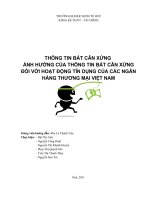Thông tin về thiên địch
Bạn đang xem bản rút gọn của tài liệu. Xem và tải ngay bản đầy đủ của tài liệu tại đây (2.52 MB, 24 trang )
ALL ABOUT
NATURAL
ENEMIES
#Biocontrol
Hypoaspis miles
HYPOASPIS MILES
Target Pests Fungus gnats (Bradysia spp.),
Western flower thrips (Frankliniella occidentalis)
Life Cycle
The complete life cycle takes about 14 days at 25oC, 70-80%RH.
•
Optimum temperature: 200C (18 days).
•
The sex ratio is equal, 1:1 females to males.
•
Eggs hatch in 2-3 days into young nymphs.
•
Each Hypoaspis consumes 1-5 prey per day. It can also survive as a
scavenger, feeding on algae and plant debris.
For Best Results
•
Apply Hypoaspis shortly within the first few weeks of planting and before Fungus gnats levels reach
more than 20 adults/trap/week.
•
To control high numbers of FG, use of Hypoaspis can be integrated with insect parasitic nematodes (e.g.,
Steinernema spp.) and Bacillus thurinigiensis israelensis (BTI), both of which control the larval stage of FG.
ATHETA CORIARIA
Target Pests Shore flies (Ephydridae)
Fungus gnats (Sciaridae)
Western flower thrips (Frankliniella occidentalis)
Life Cycle
The complete life cycle takes about 17 days at 260C; 60-75% RH.
•
•
•
•
Optimum temperature: 260C.
The sex ratio is equal, 1:1 female to male.
Eggs hatch in 3-4 days into young larval stages.
Each A. coriaria consumes 10-20 thrips prey per day or 150 pest FG
eggs per day.
For Best Results
Atheta has a longer life cycle and takes longer to establish than the Hypoaspis predatory mite so Atheta
should be used along with Hypoaspis for best results.
AMBLYSEIUS CUCUMERIS
Target Pests Western flower thrips (Frankliniella occidentalis)
Onion thrips (Thrips tabaci); Cyclamen, and Broad Mites.
Life Cycle
A complete life cycle takes about 9 days at 25°C, >70%RH.
•
Optimum temperature: 200C (10-12 days).
•
The sex ratio is 60-70% females.
•
Females lay 1-3 eggs per day for an average of 35 eggs.
•
They hatch in about 3 days.
•
Adults live for up to 30 days
•
Eat an average of 6 1st thrips larvae per day.
For Best Results
Use Cucumeris along with other thrips predators such as Orius spp. on flowering plants and Hypoaspis
to control thrips pupae in the growth media.
PleaseNote: Where Persimilis is being used for control of spider mite, avoid heavy applications of
Cucumeris. Cucumeris feed on spider mite eggs, which may limit the food supply for immature Persimilis
and reduce their effectiveness.
AMBLYSEIUS SWIRSKII
Target Pests Young larvae of various thrips species
Eggs and larvae of whitefles.
Life Cycle
The life cycle takes about 7 days at 250C, >70% RH.
•
•
Optimum temperature: 250C.
The sex ratio is 60-70% females.
•
Egg: 2-3 eggs per day, hatch in 1.7 days.
•
Life span: 25.8 days
•
Eat an average of 4 1st thrips larvae per day and overpowered
easily than 2nd larvae.
For Best Results
• Release when plant starts flowering. A. swirskii doesn’t feed on adult stages of its prey, therefore
•
preventative releases are recommended early in the crop cycle before pest shows up.
Complement its action with parasitic wasps for older larval stages of whitefly and with pirate bugs for
older thrips larvae and adults.
AMBLYSEIUS MONTDORENSIS
Target Pests Young larvae of various thrips species
Greenhouse Whitefly and Silverleaf Whitefly.
Life Cycle
At optimum temperature 25oC; >70%RH. Montdorensis takes about
6-7 days to complete their lifecycle. An adult predator consumes an
average of 14 thrips larvae per day, feeding on both first and
second instar prey.
For Best Results
•
Weed management and screening (in protected crops) should be used
to reduce the number of adult thrips and whitefly entering the crop.
•
Complementary thrips biocontrol agents include Orius predatory bugs
(which feed on all stages of thrips) and Hypoaspis soil-dwelling predatory mites (which kill thrips pupae
at ground level). Complementary whitefly biocontrol agents include the parasitoid wasps Eretmocerus
hayati (Silverleaf whitefly) and Encarsia formosa (Greenhouse whitefly).
ORIUS SPP.
Target Pests Western flower thrips (Frankliniella occidentalis)
Onion thrips (Thrips tabaci)
Life Cycle
A complete life cycle takes about 14-21 days at 25°C.
•
Optimum temperature: 210C (21 days).
•
The sex ratio is 50-60% females.
•
Females lay 2 eggs per day, with an average of 30 eggs in their
lifetime. Eggs hatched in 4-5 days.
•
Eat an average of 20 nymphs or 6-7 adults thrips per day.
•
Adults live for 21-28 days.
For Best Results
Until thrips populations are established, use the predatory mite Cucumeris (Amblyseius cucumeris) on
cucumber. To prevent Orius from diapausing supplemental lighting must be provided to increase the
day length to 14 hours or longer.
PleaseNote: Orius will diapause in the fall, when day lengths are less than 12.5 - 14 hours.
PHYTOSEIULUS PERSIMILIS
Target Pest Two-spotted spider mite (Tetranychus urticae)
Life Cycle
A complete life cycle takes about 5 days at 25°C, >70% RH.
•
Optimum temperature: 250C.
•
There are 4 times more females in the population than males
•
Females lay 2-3 eggs per day for an average of 60 eggs over their
35-day lifetime. The eggs hatched in 2-3 days.
•
Newly hatched predators do not eat, but later stages and adults
feed on all stages of the prey. Each predator consumes between 530 prey (eggs or mites) per day.
For Best Results
•
Persimilis needs relative humidities greater than 70% to survive, particularly in the egg stage. In low
humidity conditions, raise the humidity by lightly misting plants or wetting walkways.
•
Where temperatures and humidity above 20-27°C; <60% RH can be maintained, the predator
Neoseiulus californicus can also be used with Persimilis.
NEOSEIULUS CALIFORNICUS
Target Pests Two-Spotted Spider mite (Tetranychus urticae); FruitTree Red Spider Mite (Panonychus ulmi); Citrus Red Mite
Life Cycle
(Panonychus citri); other spider mite species.
The life cycle takes about 6 days at 25°C, 40-80% RH.
•
•
•
•
Optimum temperature: 300C (4 days).
The adult predatory mite lives about 20 days. She lays eggs for 14
days (with an average of 3 eggs a day).
The eggs hatch after 1-2 days.
Californicus is able to consume 5 adults spider mites daily.
For Best Results
Californicus works best when used preventatively, or when spider mites are first noticed on the crop. The
best results are seen when Californicus is allowed to build up before the spider mite populations are
able to establish themselves.
PleaseNote: Neoseiulus californicus develops faster when consuming the two-spotted spider mite.
APHIDIUS SP.
Target Pests Melon aphid (Aphis gossypii),
Green peach aphid (Myzus persicae), and related aphids.
Life Cycle
A complete life cycle takes about 10 days at 25 ºC, >65%RH.
•
•
•
Optimum temperature: 250C.
The sex ratio is females than males (50-60% females).
Each female lays about 100-200 eggs in aphids. Parasitized turn into
golden brown mummies after 7-12 days. Four to six days later the new
wasps will emerge. The 2nd and 3rd instars aphids are preferred (all stages
can be parasitized).
For Best Results
In situation, aphid populations grow too fast to be controlled by the parasite alone therefore it is advisable
to introduce additional aphid predators such as Geocoris spp. and Ladybeetles.
PleaseNote:
•
•
The size of the adult parasite and the number of eggs it can lay, depends on the size of the aphid.
Aphidius does not attack many common aphid species, such as potato aphids (Macrosiphum euphorbiae)
so if mummies are not present check aphid identification.
TRICHOGRAMMA SPP.
Target Pests Several species of moths.
Life Cycle
A complete life cycle takes about 8-9 days at 250C, >60% RH.
•
•
•
•
•
•
Optimum temperature: 210C (14 days).
Sex ratio in the population is about equal (50% females).
Mated females lay 60-70 eggs in over a period of 1-2 weeks.
Larvae take 10 days within the moth egg, which turns brown or black.
Adults begin to emerge within 2-3 days. Males emerge slightly earlier
and await female 20-27 emergence for mating.
Total life span maybe 7-75 days depending upon temperature,
relative humidity and species of moth parasitized.
For Best Results
Because Trichogramma are weak flyers, they must be well distributed throughout the crop. Use Bacillus
thuringiensis, Eocanthecona furcellata, and Geocoris spp. to control Caterpillars until Trichogramma is
well established.
EOCANTHECONA FURCELLATA
Target Pests Many Lepidopterous pests
Life Cycle
A complete life cycle takes about 18.7 days at 29°C, >65% RH. The life
cycle of female imago (37.4 days) and male (35.2 days).
•
•
•
•
•
•
1st nymphal instar takes 4.08 days.
2nd instar takes 3.42 days.
3rd instar takes 2.97 days.
4th instar takes 3.06 days.
5th instar takes 5.25 days.
The fecundity rate of E. furcellata is 134.8 eggs/female, while percentage of egg
hatching is 82.9% with egg incubation period lasting for 10.1 days.
For Best Results
Combine with Trichogramma sp. and BTK powder for the best pest control effect.
NESIDIOCORIS TENUIS
Target Pests Whiteflies (Bemisia tabaci / Trialeurodes vaporariorum)
Aphids (Macrosiphum euphorbiae/ Aphis gossypii)
Thrips (Frankliniella occidentalis)
Moths (Spodoptera exigua)
Life Cycle
On tomato, development takes about 21.8 days at 25°C (65±5% RH;
16L:8D; Ultra-Violet LED λ=385 nm). Optimum temperature: 250C.
•
•
•
At 17°C, a female lays about 100-150 eggs on tomato, 250-300 eggs
on cucumber and 450-600 eggs on eggplant.
Nesidiocoris nymphs are 1-4mm long and cannot fly.
Adults are able to prey on over 30 T. absoluta eggs per day.
PleaseNote:
•
•
•
•
•
Attractive fertilizing NH4+ > NO3- > Ca (NO3)2.
At 35-370C ability oviposition declines by 10%. Above 370C make an adults die.
The population of N. tenuis is too large, i.e. when more than 1.5 inds/tomato plant.
There is no or less prey.
In sensitive crops and varieties such as cherry tomatoes and small-truss tomato types.
GEOCORIS SPP.
Target Pests Predaceous on mites and a wide variety of small insects.
Life Cycle
The life cycle is development takes about 7-9 days at 25oC; 60-80% RH.
•
•
•
•
•
•
•
Optimum temperature: 250C.
Eggs that are laid singly on leaves or stems hatch in one week.
The sex ratio is equal, 1:1 females to males.
They have five nymphal instars, each of which lasts from 4-6 days.
Both nymphs and adults are predaceous.
Adults live approximately one month and a female can lay up to 300 eggs.
Feed on a wide variety of prey smaller than themselves (eggs and small larvae
of most Lepidopteran pests, on the eggs and nymphs of plant bugs, and on all life stages of whiteflies,
mites and aphids).
PleaseNote:
Chinch bugs, a pest of turfgrass, resemble big-eyed bugs and managers sometimes mistakenly spray
when the biological control agent is found.
Table 1.1 Common Pests in Vietnam (and personal observations).
PEST GROUP & ORDER
COMMON NAME
SCIENTIFIC NAME
Flies and Midges
(Diptera)
Fungus gnats
Orfelia and Bradysia species
Western flower thrips
Frankliniella occidentalis Pergande
Onion thrips
Thrips tabaci Lindeman
Poinsettia thrips
Echinothrips americanus Morgan
Palm thrips
Parthenothrips dracaenae Heeger
Tobacco thrips
Thrips parispinus Karny
Rose thrips
Thrips fuscipennis Haliday
European flower thrips
Frankliniella intonsa Trybom
Two-spotted spider mite
Tetranychus urticae Koch
Bulb scale mite
Steneotarsonemus laticeps Halbert
Broad mite
Polyphagotarsonemus latus Banks
Thrips
(Thysanoptera)
Spider mite
Tarsonemid mite
(Trombidiformes)
Table 1.2. Common Pests in Vietnam (and personal observations).
PEST GROUP & ORDER
Aphids
(Hemiptera)
Caterpillars
(Lepidoptera)
Whiteflies
(Hemiptera)
Mealybugs
(Hemiptera)
COMMON NAME
SCIENTIFIC NAME
Green peach aphid
Myzus persicae Sulzer
Cotton aphid
Aphis gosyppii Glover
Foxglove aphid
Aulacorthum solani Kaltenbach
Potato aphid
Macrosiphum euphorbiae Thomas
South American
tomato pinworm
Tuta absoluta Meyrick
Cotton leafworm
Spodoptera litura
Tomato looper
Plusia chalcites
Tobacco whitefly
Bemisia tabaci Gennadius
Greenhouse whitefly
Trialeurodes vaporariorum Westwood
Citrus mealybug
Planacoccus citri Risso
Long-tailed mealybug
Pseudococcus longispinus
Targioni-Tozzetti
Obscure mealybug
Pseudococcus viburni Signoret
ANIMAL AND PLANT
PROTECTION METHODS1
BIOTECHNIQUES
(e. g. Breeding and selection, genetic engineering)
CULTURAL
NON-SELFSUSTAINING
CHEMICAL
NON-SELFSUSTAINING
Crop Rotation
Multicropping4
Tillage
Sanitation
Water Management
(Others)
INORGANIC
NATURAL
SYSTHESIZED
(INDUSTRIAL)
Sulfur
(Others)
Copper Sulfate
(Others)
BIOLOGICAL
NON-SELFSUSTAINING
AUTOCIDAL
HOST PLANT
RESISTANCE2
SELF-SUSTAINING
BIOLOGICAL CONTROL
AUGMENTATION Vedalia Beetle
CONSERVATION
Wheat3
(Cottony-cushion
scale)
OF NATURAL
(Hessian Fly) OF NATURAL
Klamath
Beetle
5
ENEMIES
ENEMIES
Grape
(Klamath Weed)
(Management
(Phylloxera) Trichogramma
Rust (Chondrilla juncea)
Practices)
(Others)
ORGANIC
(Cornborer)
Antagonistic microorganisms
Encarsia
(Plant pathogens)
(Whitefly)
Some baculoviruses
SYNTHESIZED
SYNTHESIZED BY
Virus
(Rhinoceros beetle)
(INDUSTRIAL)
LIVING ORGANISMS
(granulosis, NP)
Some fungi
Nematodes
Some protozoa
Semiochemicals
Clorinated Hydro(Others)
(Others)
Pyrethrums
carbons
Rotenone
Organophosphates
1. List not inclusive – IPM is not included because it draws from all methods.
Toxins (B. thuringiensis)
Carbamates
2. Placed by some experts under Cultural Control.
(Others)
Pyrethroids
3. Some varieties have retained resistance for decades, while others lose resistance sooner.
4. Some forms are self-sustaining.
(Others)
Screwworm
Fruits Flies
(Others)
5. Partially self-sustaining.
Fig. 1. Schematic diagrams of the direct and indirect
interactions among plants, pests and natural enemies.
Exploitative
Competition
and
Induced
Plant
Responses
Apparent
Competition
or
Apparent
Predators
Parasitoids
Pests
Plant
*Integrated Pest Management and Pest Control – Current and Future Tactics (Book)
Intraguild
Predation
Omnivory
Hyperparasitism
or
Hyperpredation
Fig 2. A food web of pest species and their most commonly used
natural enemies in sweet pepper crops.
*Integrated Pest Management and Pest Control – Current and Future Tactics (Book)
Type
Feeding Habit
Example Commercially Available Species
Specialized mite predators
Type I
(a) Specialized predators of Tetranychus (Tetranychidae)
(b) Specialized predators of web-nest producing mites
(Tetranychidae)
(c) Specialized predators of tydeoids (Tydeoidea)
Type II Selective predators of Tetranychid mites
(a) Phytoseiulus persimilisa, Phytoseiulus macropilis
(b) Typhlodromus (Anthoseius) bumbusae
(c) Typhlodromina eharai, Proprioseiopsis sp.
Neoseiulus californicusa, Neoseiulus fallacis,
Neoseiulus longispinosus,
Generalist predators
Type
III
Type
IV
(a) Generalists living on pubescent leaves
(b) Generalists living on glabrous leaves
(c) Generalists living in confined spaces of
dicotyledonous plants
(d) Generalists living in confined spaces of
monocotyledonous plants
(e) Generalists from soil/litter habits
(a) Kampimodromus aberrans, Galendromus
occidentalis, Typhlodromus pyri, Phytoseius finitimus
(b) Amblyseius swirskiia , Amblydromalus limonicus,
Transeius montdorensisa , Amblyseius cucumerisa
(c) Amblyseius herbicolus, Iphiseius degenerans,
(d) Neoseiulus baraki, Neoseiulus paspalivorus
(e) Neoseiulus barkeri
Specialized pollen feeders/generalist predators
Euseius sp. (E. gallicusa, E. stipulatus, E. scutalis)









